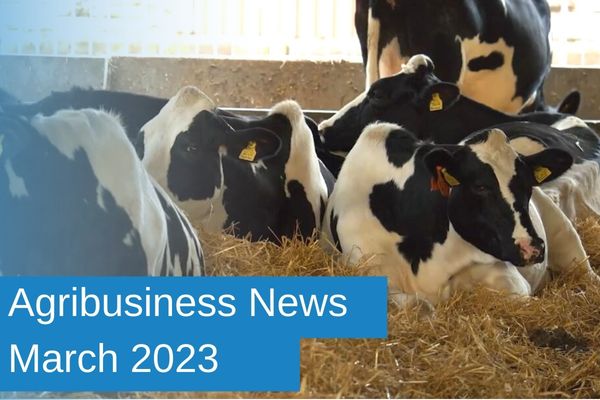Agribusiness News March 2023 – Sector Focus: Dairy
1 March 2023Milk Price and Input Costs – Where is it heading and what are the options?
Milk Output and Cost of Production
GB milk production for the 2022/23 milk year is projected to be 12.44 billion litres (0.7% above 2021/22), with production to mid-Feb 23 being ~ 3% higher than mid-Feb 22. With more milk available, a building of product stocks and reduced sales of dairy products due to incomes being squeezed, commodity prices are falling, resulting in many processors announcing sizable price cuts for March milk.
Outlook
With some farmers faced with low forage stocks due to last year’s dry summer, turning out cows early could exacerbate the current over-production and potentially drive down prices further or quicker. However, equally, falling milk prices and high prices for cull cows may prompt producers to cull unproductive cows and/or, to scale back production, or to decide to give up dairying. This could result in a potential fall in milk production, especially if coupled with a cold, late spring and drought conditions in early summer, which could help stabilise farmgate milk prices.
With falling milk prices, it is important that producers don’t make ‘knee jerk’ changes with regards cost of production that could harm herd health, fertility or milk yield going forward.
Cost of Production and Input costs
Factoring in the approaching spring flush of milk, producers are concerned how low prices might drop given that the average cost of production is currently estimated at 45ppl.
Fertiliser & Grassland Management: Given that linked to falling fuel prices, fertiliser prices have dropped significantly (imported Ammonium Nitrate fell by £188/t from Oct 22 to £682/t in Jan 22 and is expected to drop into the £400’s/t soon), producers should not cut back on fertiliser requirements, as it will reduce grass yield and nutritional quality, leading to higher feed costs next winter.
Tightening up on grassland management by opting for rotational grazing/paddock grazing over set stocking will help to improve grass production and quality over the grazing season.
Is there potential to turn stock out earlier than normal e.g. in-calf heifers and low-yielders? Use a plate meter or sward stick to measure grass covers and look to graze the driest fields, even if only for a few hours a day will save on bedding, forage and concentrate costs.
Feed & Feeding: With barley now below £200/t ex farm, some lower protein cereal-based purchased feeds have reduced by ~ £10-15/t over the last month. However, soya has soared to £590/t delivered (linked to the drought in Argentina), which has increased the demand on mid-proteins such as rapeseed meal and distillers’ dark grains.
With straights prices up on average 15% since the Ukraine war began, unfortunately the reduction in cereals will have little impact on overall farm feed costs. However, if not currently contracted until the summer, test all forages to review rations and shop around for feeds – be prepared to try something new and make changes on the back of sound nutritional advice. Equally, review management practices i.e. more regular push ups, improving ration presentation and minimising sorting behaviour can all help increase forage and overall dry matter intakes to drive milk output.
Health and Efficiency
Health is wealth. Producers are advised to keep accurate records of production diseases, lameness, mastitis, and fertility issues which can affect feed conversion efficiency and reduce milk output. These should be reviewed regularly and discussed with the business’s vet and nutritionist with regards potential areas for improvement.
Individual cow productivity is important. Scrutinise their milk production in relation to their feed or keeping costs and determine whether they justify their position in the herd. If there are sufficient heifers coming through and cull prices are good, it could be worth culling less productive animals.
Finances
Faced with falling milk prices, some producers may be tempted to cut inputs to reduce their costs of production, especially if faced with cashflow issues. However, care must be taken ensure cuts can be made without harming herd health, fertility or milk yield. Keeping an open dialogue with lenders and suppliers will help to manage outstanding creditors and overdraft levels. Equally, given the uncertainty in milk price and when the milk market may start to stabilise, sitting tight and not making any major changes, or scaling back slightly to take advantage of high cull cow prices is well worth considering.
Sign up to the FAS newsletter
Receive updates on news, events and publications from Scotland’s Farm Advisory Service

